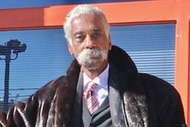Create a free profile to get unlimited access to exclusive videos, breaking news, sweepstakes, and more!
What Led Up To Malcolm X's Break With The Nation Of Islam – And Ultimately His Death?
Malcolm X was a fierce supporter Nation of Islam leader Elijah Muhammad, but came to view his former mentor's teachings as "narrow‐minded confines."

Netflix's new documentary "Who Killed Malcolm X?" raises many questions about whether the right people were charged in the civil rights activist's killing, but what is clear is the fractured relationship he'd developed with the leadership of a black Muslim group he was once close to.
Growing up in the Midwest, Malcolm X and his family faced threats from the Ku Klux Klan that forced his family to flee their home. Most egregiously, his father James Earl Little was murdered by a white supremacist group and authorities refused to prosecute those responsible, according to PBS' American Experience.
Only seven years after his father's death, Malcolm's mother was institutionalized and he was sent into foster care.
He later dropped out of school and moved to the Boston area –– where he fell into criminal activity and was eventually sent to prison on a 10-year sentence. During his time in prison, he became drawn to the teachings of the Nation of Islam, a nationalist political and religious movement that preached black separatism, and its leader Elijah Muhammad.
Why did he change his last name to 'X'?
Following his release from prison and joining of the Nation of Islam, Malcolm changed his surname from Little to X.
"The Muslim's 'X' symbolized the true African family name that he never could know. For me, my 'X' replaced the white slavemaster name of 'Little' which some blue-eyed devil named Little had imposed upon my paternal forebears. The receipt of my 'X" meant that forever after in the nation of Islam, I would be known as Malcolm X. Mr. Muhammad taught that we would keep this 'X' until God Himself returned and gave us a Holy Name from His own mouth," Malcolm X wrote in his autobiography about the significance of the name change.
The naming convention was not unique to Malcolm X and was common throughout the Nation of Islam at the time.
In fact, two men who were later convicted in his killing, Norman 3X Butler and Thomas 15X Johnson, used the same naming convention with the addition of numbers. The numbers in front of the two men's Xs related to how many people in a given Nation of Islam mosque community had that first name, with the number indicating the order in which adherents joined the community.
For example, Thomas 15X Johnson was named as such because he was the 15th person named Thomas to join Elijah Muhammad’s Temple No. 7 on 116th Street and Lenox Avenue in New York, according to a 2007 story from New York Magazine. Likewise, Malcolm can be inferred to be the first person with the name "Malcolm" to join his respective religious community.
What happened after Malcolm X joined the group?
After Malcolm X joined the NOI, he quickly rose to become its national spokesman as membership ballooned through the 1950s and early 1960s. He also served as a minister for the Temple No. 7 in Harlem, according to resources from Columbia University.
But in 1964, Malcolm X would publicly break with the group following his suspension by Muhammad, the New York Times reported at the time. Malcolm X was suspended for comments he made in the wake of President John F. Kennedy's assassination –– calling it a case of the “chickens coming home to roost," the Times reported.
Malcolm contended his comments about JFK were misinterpreted, but the split between him and the Nation of Islam would become permanent.
“I have reached the conclusion,” Malcolm said at the time, “that I can best spread Mr. Muhammad's message by staying out of the Nation of Islam and continuing to work on my own among America's 22 million non‐Muslim Negroes.”
After leaving the group, Malcolm X converted to Sunni Islam and undertook the hajj, the annual Islamic pilgrimage to Mecca, he explains in his autobiography. During his pilgrimage, Malcolm would change his name again, this time to el-Hajj Malik el-Shabazz.
"On this pilgrimage, what I have seen, and experienced, has forced me to rearrange much of my thought-patterns previously held, and to toss aside some of my previous conclusions," he wrote in a letter to his community in Harlem, made available by the University of Georgia.
"I have never before seen sincere and true brotherhood practiced by all colors together, irrespective of their color," he wrote.
Though what ended up putting him at odds with the Nation of Islam would be his denouncement of Elijah Muhammad.
“For 12 long years I lived within the narrow‐minded confines of the ‘strait‐jacket world’ created by my strong belief that Elijah Muhammad was a messenger direct from God Himself, and my faith in what I now see to be a pseudoreligious philosophy that he preaches. But as his then most faithful disciple, I represented and defended him at all levels ... and in most instances, even beyond the level of intellect and reason," Malcolm X wrote of Muhammad, according to the Times, who he also called a "faker" in his writing.
What happened after he broke with the group?
Following his return to the United States, Malcolm X would see increased threats to his life, including a firebomb attack on his home in 1965 –– all while leaders of the Nation of Islam publicly called for his death, the Washington Post reported.
Ultimately, Malcolm was assassinated on Feb. 21, 1965 in New York City's Audubon Ballroom as he prepared to give a speech. One of the gunmen, Talmadge Hayer, was caught at the scene. Johnson and Butler were later arrested and also charged in the killing.
However, while Hayer –– also known by the names Thomas Hagan and Mujahid Abdul Halim –– had confessed to killing Malcolm X, he also maintained Islam and Aziz had nothing to do with the murder. He later signed an affidavit identifying four different men as his co-conspirators, but the case was ultimately not reopened.
Johnson and Butler later changed their names to Khalil Islam and Muhammad Abdul Aziz, respectively, and both were later paroled. Aziz continues to maintain his innocence in the killing to this day; Islam maintained his innocence until his death in 2009.
All six episodes of "Who Killed Malcolm X?" are available to stream on Netflix.

























